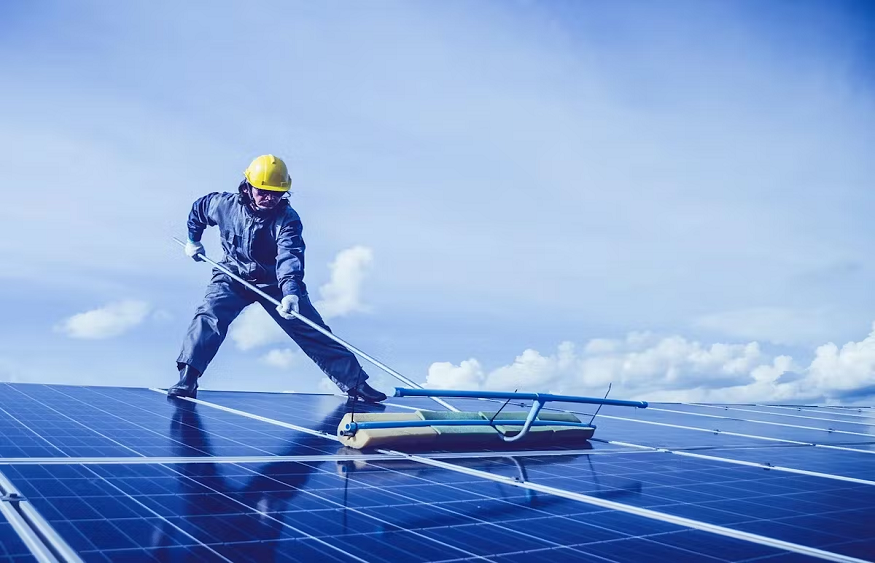In recent years, the focus on eco-friendly living and sustainable home improvements has grown significantly. Homeowners are increasingly seeking ways to reduce their carbon footprint and create more energy-efficient living spaces.
One powerful approach to achieving an eco-friendly home makeover is by combining solar panels, air conditioning, and underfloor heating and cooling systems. In this article, we will explore the top 10 home improvements to make your home more environmentally friendly.
We will also discuss solar panels, air conditioning, and underfloor heating and cooling systems, along with their respective pros and cons.
Top 10 Home Improvements for an Eco-friendly Home
- Solar Panels: Installing solar panels is a top eco-friendly home improvement. They harness the sun’s energy and convert it into electricity, reducing your reliance on traditional power sources and lowering your carbon footprint.
- Energy-Efficient Appliances: Upgrading to energy-efficient appliances, such as refrigerators, dishwashers, and washing machines, helps minimize energy consumption and reduces greenhouse gas emissions.
- LED Lighting: Replacing traditional incandescent bulbs with energy-efficient LED lighting significantly reduces energy usage and extends the lifespan of bulbs.
- Smart Thermostats: Installing smart thermostats allows for precise control of heating and cooling systems, optimizing energy usage and reducing waste.
- Water-saving Fixtures: Upgrading to water-saving fixtures, such as low-flow showerheads and faucets, helps conserve water and reduce overall water consumption.
- Insulation Upgrades: Improving insulation in walls, roofs, and windows minimizes heat loss in winter and heat gain in summer, resulting in reduced energy usage for heating and cooling.
- Rainwater Harvesting: Implementing rainwater harvesting systems allows you to collect and reuse rainwater for purposes such as watering plants or flushing toilets, reducing reliance on treated water.
- Composting: Creating a composting system for organic waste helps reduce landfill waste and produces nutrient-rich compost for gardening.
- Natural Ventilation: Designing or retrofitting your home to maximize natural ventilation reduces the need for artificial cooling and improves indoor air quality.
- Energy-efficient Windows: Installing energy-efficient windows with double or triple glazing reduces heat transfer, enhances insulation, and improves energy efficiency.
Solar Panels: Pros and Cons
Solar panels are an excellent choice for eco-friendly homes, as they generate clean and renewable energy. Let’s explore their pros and cons:
Pros:
- Renewable Energy Source: Solar panels harness the sun’s energy, which is an abundant and renewable resource.
- Reduced Energy Bills: By generating your electricity, you can significantly lower your energy bills.
- Lower Carbon Footprint: Solar panels produce clean energy, reducing greenhouse gas emissions and environmental impact.
- Long Lifespan: Solar panels are durable and can last for 25 years or more with proper maintenance.
- Financial Incentives: Many governments and utility companies offer incentives and tax credits for installing solar panels.
Cons:
- High Initial Costs: The upfront investment for solar panels can be substantial, although costs have decreased significantly in recent years.
- Weather Dependence: Solar panels rely on sunlight, so their energy production varies depending on weather conditions and location.
- Space Requirement: Sufficient roof space or an open area on your property is needed to install an efficient solar panel system.
- Maintenance Needs: While solar panels generally require minimal maintenance, occasional cleaning and monitoring are necessary to ensure optimal performance.
Air Conditioning: Pros and Cons
Air conditioning provides comfort during hot summer months, but it also has its pros and cons when it comes to eco-friendliness. Let’s examine them:
Pros:
- Comfortable Indoor Environment: Air conditioning maintains a cool and comfortable temperature indoors, enhancing the quality of life.
- Improved Air Quality: Many air conditioning systems include filters that remove pollutants and allergens from the air, improving indoor air quality.
- Increased Productivity: A comfortable working or living environment created by air conditioning can lead to increased productivity and well-being.
Cons:
- Energy Consumption: Air conditioning systems consume significant amounts of energy, contributing to higher electricity usage and greenhouse gas emissions.
- High Operational Costs: Cooling a home with air conditioning can result in higher energy bills, especially if the system is inefficient or improperly used.
- Environmental Impact: Traditional air conditioning systems that rely on refrigerants can harm the environment if not properly maintained or if refrigerants are released.
Underfloor Heating and Cooling: Pros and Cons
Underfloor heating and cooling systems offer efficient and comfortable temperature control. Here are the pros and cons to consider:
Pros:
- Comfortable Radiant Heat: Underfloor systems provide even and comfortable warmth during colder months, eliminating drafts and cold spots.
- Energy Efficiency: Underfloor systems operate at lower temperatures compared to forced-air systems, resulting in energy savings.
- Space Saving: With underfloor systems, there’s no need for bulky radiators or ductwork, maximizing usable space.
- Design Flexibility: Underfloor systems can be installed beneath various flooring materials, providing design versatility.
Cons:
- Installation Complexity: Installing underfloor heating and cooling systems can be more complex and costly compared to traditional systems, requiring professional expertise.
- Slower Response Time: Underfloor systems have a slower response time as the floor needs to heat up or cool down before the effects are felt in the room.
- Retrofitting Challenges: Retrofitting underfloor systems into existing homes may involve significant modifications and may not be suitable for all types of flooring.
By combining solar panels, air conditioning, and underfloor heating and cooling systems, homeowners can create an eco-friendly home that maximizes energy efficiency, reduces reliance on non-renewable energy sources, and minimizes environmental impact. Embracing these technologies enables a greener future while enjoying comfortable living spaces.
By implementing eco-friendly home improvements, such as installing solar panels, choosing energy-efficient appliances, and utilizing underfloor heating and cooling systems, you can contribute to a sustainable and environmentally conscious lifestyle.
Embrace the combination of solar panels, air conditioning, and underfloor heating and cooling to transform your home into an eco-friendly haven that benefits both your well-being and the planet.
Be Green and Save the Planet
Embracing underfloor heating and cooling systems powered by solar panels not only benefits individual homeowners but also plays a crucial role in our collective effort to save the planet. By reducing our reliance on fossil fuel-based energy sources, we can significantly decrease greenhouse gas emissions, combat climate change, and pave the way for a sustainable future for generations to come.
Underfloor systems offer an efficient and environmentally friendly approach to home heating and cooling. Operating at lower temperatures and harnessing the power of clean energy from solar panels, they provide a sustainable solution for homeowners. By embracing these technologies, we can make a positive impact on the environment while enjoying the unparalleled comfort and energy efficiency that underfloor heating and cooling systems provide.
These systems represent the future of home comfort and energy efficiency, promising even heating or cooling, exceptional energy performance, and compatibility with renewable energy sources like solar panels. By incorporating underfloor systems powered by solar energy into our homes, we are taking significant steps towards a greener and more sustainable future.
Let us embrace the future of home heating and cooling, where underfloor systems fuelled by solar energy become the norm. Together, we can create a greener and more energy-efficient home environment that benefits both ourselves and the planet we call home.




